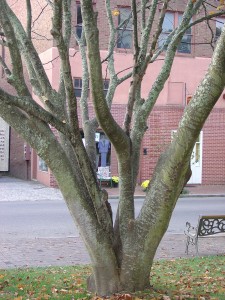American yellowwood (Cladrastis kentukea) is a medium-sized flowering tree. In the month of May, a beautiful yellowwood tree is in bloom somewhere in the Southern Appalachian region (USDA zone 6 and 7). The 1- 1 1/2 inch white pea blossoms comprise the 8-14 inch long wisteria-like panicles which drape from branch and twig tips.
Yellowwood may bloom 2 to 3 consecutive years and not flower again for 1 to 2 years. The triggering mechanism for flowering is not clearly understood. A complex of environmental and physiological factors may be involved.
Over the past two decades the weather across the Southern Appalachian region can only be described as “extreme”, unusually dry, hot summers and unseasonably mild winters. A physiological condition called “biennial bearing” may be in play here. If a tree sets an unusually heavy seed load one summer, few to no flowers are initiated the following spring.
Whether it flowers or not, yellowwood makes a fine landscape shade tree for any sized landscape. Plant in well drained, slightly acidic soil in full sunlight. Its dark green compound leaves remain pest free from spring until early autumn. Yellowwood’s bright yellow fall color arrives at a time when many trees have already defoliated. Its smooth gray colored bark is very beech-like and has multi-seasonal interest.


 Posted in
Posted in 
